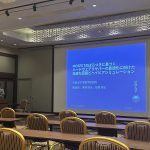2025年12月19日〜21日に中国南京市で開催されるAsian Hardware Oriented Security and Trust Symposium (AsianHOST 2025)に、次の論文が採録されました。
- Zhenzhe Chen, Weirong Dong, Kunyang Liu, and Takashi Sato, “ARXPUF: A modeling attack resilient lightweight strong PUF based on Add-Rotate-Xor,” Proc. Asian
Hardware Oriented Security and Trust Symposium (AsianHOST), 2025, accepted.



